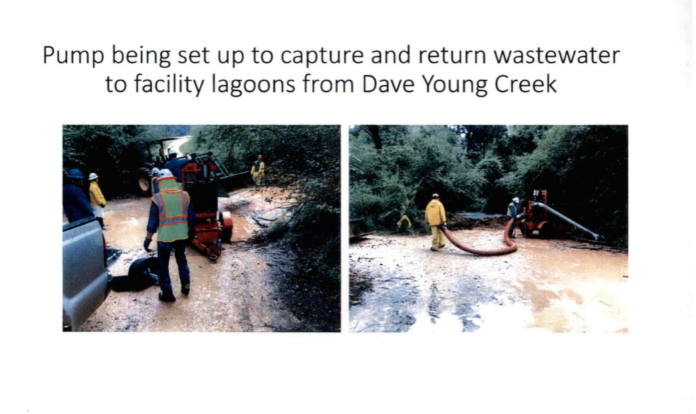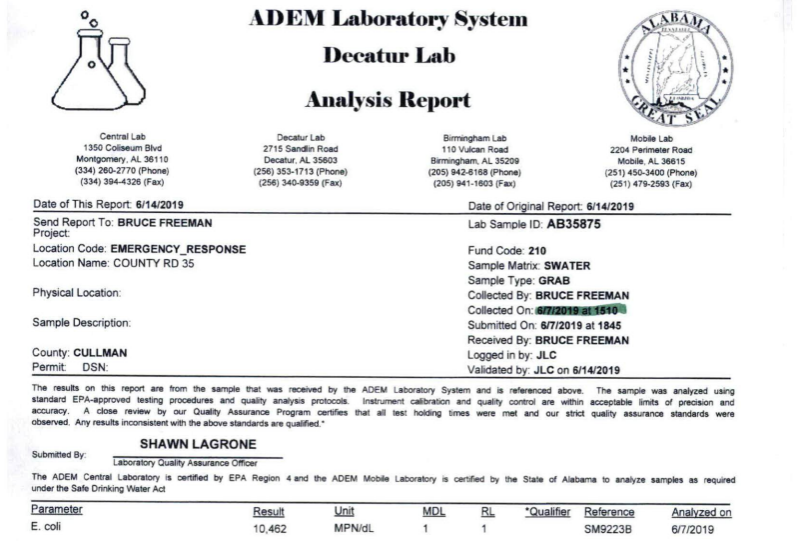
HANCEVILLE, Ala. – Black Warrior Riverkeeper (BWR), a north Alabama environmental organization on Wednesday posted to its Facebook page a large multi-page document found in an e-file on the Alabama Department of Environmental Management (ADEM) website, containing detailed information about the June 6, 2019 spill at the Tyson/River Valley Ingredients (RVI) plant in Hanceville, including a collection of reports on water quality sampling done the day of the spill and in the days following. The reports show a significantly higher level of E. coli bacteria in the Mulberry Fork immediately following the spill than ADEM reported to the public a few days later.
In its Facebook post, BWR claimed, “Among other things, the report shows that ADEM measured — but did not publicize — very high levels of E. coli in the Mulberry Fork shortly after the spill.”
On June 7, the day following the spill, Tyson Senior Manager for Public Relations Worth Sparkman issued a public warning, noting that “partially treated effluent is believed to have reached the Dave Young Creek, which flows to the Mulberry Fork” and saying, “In an abundance of caution, the public is encouraged to avoid recreating in Dave Young Creek or the Mulberry Fork until further notice.”
Sparkman’s press release did not include information on contamination levels, but the only water sample taken before the statement was issued was still at an ADEM lab in Decatur, which would not issue a report on its findings until June 14, seven days later. By the time the initial reports came back, E. coli and oxygen levels in the Mulberry/Sipsey river system had returned to normal, leading to suspicions about the timing.
Why the delay?
ADEM’s own documents contain a suspicious discrepancy in the lab reports- not in the results found, but in the time it took to report them.
- E. coli results for a sample taken on the afternoon of June 6 at a location where visible signs of contamination (dead and dying fish) were observed did not come back from ADEM’s Decatur lab until June 14, eight days later. They would show a massive level of contamination.
- E. coli results for a sample taken on June 7 at another location with the same visible signs of contamination also did not come back from the same lab until June 14. They would show even higher levels that the test from the previous day.
- By June 10, according to the report, “There were no dying or distressed fish at any observed location,” and ADEM “determined that response actions were complete at the (Tyson/RVI) facility.”
- On June 13, seven days after the spill, three days after cleanup at the plant was completed and three days after the river appeared visibly cleaner, new samples were taken at six different locations. The E. coli results, all showing levels well within the normal range, came back from the same lab in less than 24 hours.
On Thursday, Sept. 5 The Tribune spoke with ADEM Field Operations Chief Scott Hughes, who said that turnaround times of one to three weeks are not uncommon at ADEM labs, but that E. coli tests can often be processed in less than 24 hours, especially in emergencies.
Said Hughes, “It depends on what the test method is. Some of the tests, for instance for E. coli, that is a very quick turnaround. A lot of times, we can get those within a 24-hour period. And there are other tests that we can get within short time frames. It just depends on what the situation is and what our lab loading is at that particular time. For instance, if it’s an emergency situation, you know, typically those samples go on the front burner and are analyzed just as quickly as the chemists can get the analytical data completed.”
In reference to what constitutes an emergency situation, Hughes said, “…something that we deem to be a critical situation where we need to get the results back and make decisions based on those results, we turn those samples around just as quickly as we can get the samples on the instruments and get the data out the other side.”
Hughes went on to say quality assurance/quality control procedures have to be followed after the samples are processed, adding to the turnaround time.
The ADEM document can be located through the ADEM website in the E-File link from the home page by selecting “Water” as the media area and 892 as the master ID, then going to page 20 in the file that opens. The report is dated 06/06/2019 (the date of the incident). The document gives a detailed account of events during ADEM’s fish kill investigation from June 6 to 13 and contains photographs and the previously-mentioned water quality lab reports.
Note that the Alabama standard for the maximum safe level of E. coli in water is 298 bacteria colonies per 100 milliliters (coded as “col./100ml”) or a “most probable number” of 298 colonies per deciliter (coded as “MPN/dl;” 100 milliliters equal one deciliter), and a dissolved oxygen level (amount of oxygen in the water) of 5.5 milligrams per liter (5.5 mg/l) is generally considered to be the minimum safe level for aquatic life, according to an EPA standard published by ADEM (https://www.epa.gov/sites/production/files/2014-12/documents/alwqs_chapter335610.pdf). According to the same document, a level of 4.0 can be a minimum under “extreme conditions.”
On June 6, ADEM took water samples at the Interstate 65 crossing downstream from the Hanceville plant, and found:
- E. coli at 9678.4 MPN/dl
- Dissolved oxygen at 0.26 mg/l
At 4 p.m. on June 7, shortly after the contamination plume passed through, ADEM took water samples at the County Road 35 crossing downstream from the plant, and found:
- E. coli at 10,462 MPN/dl
- Dissolved oxygen at 0.3 mg/l
The June 7 report also noted that oxygen levels were rapidly returning to a safe range behind the plume, and that water at the County Road 35 crossing had returned to a safe oxygen level by 8 p.m. that day. The report’s notes and photos of abundant dead and dying fish throughout the area, though, indicated that the contamination plume had done tremendous damage as it passed.
Also on June 7, ADEM collected a control sample upstream from the plant, near Garden City, and found an E. coli level there of 104.6 MPN/dl.
Observations by Alabama Department of Conservation and Natural Resources (ADCNR) fisheries personnel on June 8 indicated “depressed levels” of dissolved oxygen between the CR 35 crossing and the forks of the Mulberry and Sipsey Forks, though conditions were still good at the forks. On June 9, though, ADCNR observers saw the effects of the plume after it passed through the forks, noting, “low DO levels and distressed fish.”
On June 9, Tyson/RVI and their contracted cleanup crew began collecting dead fish from the river.
On June 10, according to the report, “the rising river levels and rainwater from previous days of rain had diminished any residual impact of the release. There were no dying or distressed fish at any observed location throughout the river system. DO levels were back to normal levels for the Mulberry Fork and Sipsey Rivers at all survey locations.”
On June 13, inspectors could find no more dead fish, and took water samples at six locations along the river, finding E. coli levels of:
- 110.0 MPN/dl at Garden City Park
- 61.3 at the Interstate 65 crossing
- 48.0 at the CR 35 crossing
- 79.4 at the forks
- 39.3 upstream of Linn Park
- 10.9 downstream of Linn Park
On June 13, ADEM concluded its onsite investigation of the fish kill, and issued a public report on the following day saying, in part, “This work has now been completed and oxygen levels in the affected streams have returned to normal.”
On the same day, BWR issued its own statement which said, in part, “Our water sampling this Monday at the confluence of the Mulberry and Sipsey Forks, 28 miles downstream of Tyson, returned results for E. coli of nearly 600 col./100mL, double the maximum amount allowed by the state of Alabama in surface waters during the summer recreation season. This Tuesday, ADEM confirmed finding pathogens but did not specify where, when, or at what amount. This Wednesday, Tyson reported that dissolved oxygen was improving in the Mulberry Fork but did not specify where or when. Tyson also oddly announced that folks could start enjoying the river again, but only based that vague suggestion on improved dissolved oxygen, which has little relevance to human safety (unlike bacteria). Meanwhile, Tyson’s slug of spilled wastewater continues to head downriver. We continue to recommend that people and their pets avoid contact with the Mulberry Fork for the time being, especially where water is muddy, stinky, or carrying dead fish.”
In its post this week, BWR charged that ADEM withheld the earlier reports, saying, “ADEM did not sample for bacteria again until June 13, publishing those results unlike the prior ones.”
Copyright 2019 Humble Roots, LLC. All Rights Reserved.

An ADEM report, returned from the lab seven days after samples were taken, showed E. coli levels more than 35 times the maximum safe level at one location in the Mulberry Fork. (Image courtesy of ADEM)



















